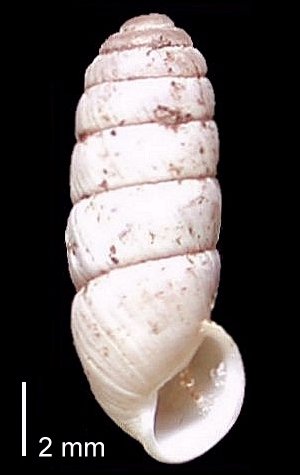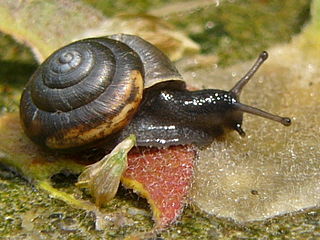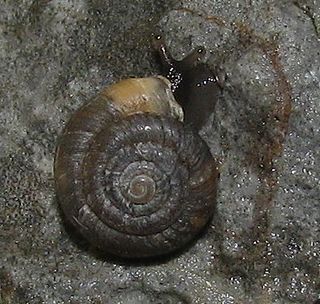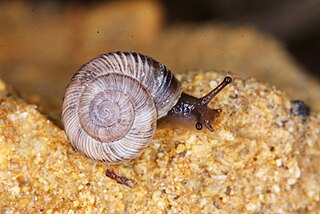
Cylindrus obtusus is a species of air-breathing land snail, a terrestrial pulmonate gastropod mollusk in the family Helicidae, the typical snails.

Trochulus is a genus of small air-breathing land snails, terrestrial pulmonate gastropod mollusks in the subfamily Trochulininae of the family Hygromiidae, the hairy snails and their allies.

Hygromiidae is a taxonomic family of small to medium-sized air-breathing land snails, terrestrial pulmonate gastropod mollusks in the superfamily Helicoidea.

Helicopsis striata is a species of air-breathing land snail, terrestrial pulmonate gastropod mollusk in the family Geomitridae.

Trochulus hispidus, previously known as Trichia hispida, common name, the "hairy snail", is a species of air-breathing land snail, a terrestrial pulmonate gastropod mollusk in the family Hygromiidae, the hairy snails and their allies.

Monacha is a genus of air-breathing land snails, terrestrial pulmonate gastropod mollusks in the subfamily Trochulininae Lindholm, 1927 of the family Hygromiidae, the hairy snails and their allies.

The reproductive system of gastropods varies greatly from one group to another within this very large and diverse taxonomic class of animals. Their reproductive strategies also vary greatly.

Inchoatia is a genus of air-breathing land snails, terrestrial pulmonate gastropod mollusks in the family Clausiliidae, the door snails.
Trochulus clandestinus is a species of air-breathing land snail, a pulmonate gastropod mollusk in the family Hygromiidae, the hairy snails and their allies.
Xerocampylaea waldemari is a species of air-breathing land snail, a pulmonate gastropod mollusk in the family Hygromiidae, the hairy snails and their allies. It was for long time seen as a member of the genus Trochulus, but moved to the genus Xerocampylaea after more comprehensive research. This species is endemic to Bosnia and Herzegovina.

Noricella is a genus of small air-breathing land snails, terrestrial pulmonate gastropod mollusks in the family Hygromiidae, the hairy snails and their allies. This genus is endemic to Austria. It contains two species, Noricella oreinos and Noricella scheerpeltzi. The name is derived from the ancient Roman province Noricum, which covered large parts of the Austrian Alps.

Helicopsis austriaca is a species of air-breathing land snail, terrestrial pulmonate gastropod mollusk in the family Geomitridae, the hairy snails and their allies.
Cernuellopsis is a genus of air-breathing land snail, a terrestrial pulmonate gastropod mollusk in the family Geomitridae. It contains a single species, Cernuellopsis ghisottii, endemic to the Italian Peninsula.
Alinda elegantissima is a species of air-breathing land snail, a terrestrial pulmonate gastropod mollusk in the family Clausiliidae, the door snails.









